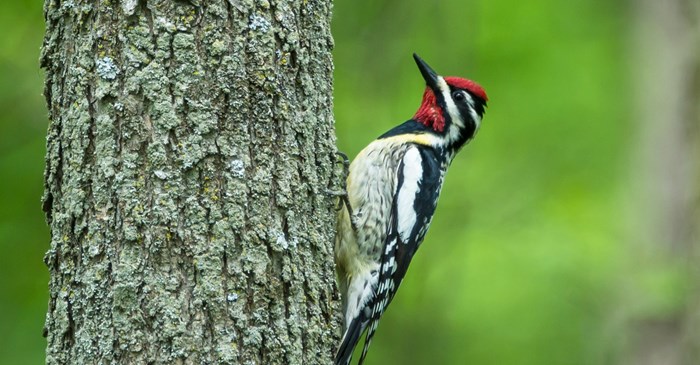The Yellow-bellied Sapsucker is a small woodpecker that really travels the distance every spring. From its winter grounds in the southeastern U.S. and Mexico, these birds will make their way north to their summer nesting grounds. In the month of May, they’ll start reappearing in woods, especially ones that feature plenty of new-growth trees, in the northern-most states and Canada.
Appearance and sound
The adult males birds feature red caps and red throats, their bodies richly patterned with black and white bars and spots. Their body type is described as small to medium and stocky. There is a pale yellow area on the belly, surrounding a black bib. Adult females are similar in coloring and markings, but will not have the red throat. If you hope to spot them, learn their mewing call and patterned tappings.
Sapwells
Another way to discover their presence is to look for the physical signs they leave behind. In the trunk of young trees, you might see orderly rows of small holes called sapwells, sometimes round, sometimes rectangle shaped. Basically, these are holes drilled by the Yellow-bellied Sapsucker to access the sap flowing beneath the surface of the bark. They’ll probe into these holes with their beaks and lick up any sap they can reach — along with ants or other insects attracted by the sugary secretions. Other wildlife drawn to these sapwells include hummingbirds, bats and porcupines.
Nesting season
Like other woodpecker species, instead of singing, drumming is a key method of communication when it’s mating season. If they can find something metal that really rings, such as a chimney or a sign, so much the better. (Homeowners may disagree, but at least the machine-like drumming is short-lived.)
In spite of their strong preference for new-growth trees, like other woodpeckers, they make use of dead branches for nesting sites. Males will spend two to three weeks making a 10-inch-deep cavity in the tree. Pairs will raise one brood a year, and are known to reunite in subsequent seasons.
Feeding
If you live near new-growth woods or have young birch or maple in your yard, you could very well attract a Yellow-bellied Sapsucker. Fill your feeder with Lyric Fruit & Nut Mix, which has plenty of sweet dried fruits, as well as seeds and nuts that they and other colorful birds love to eat.
